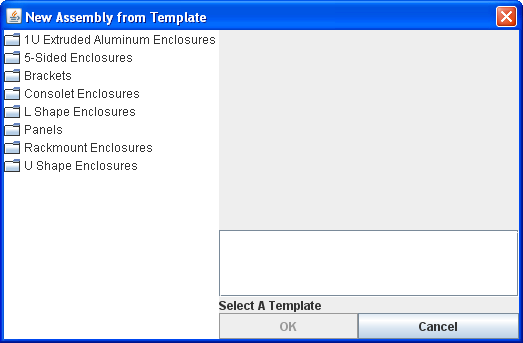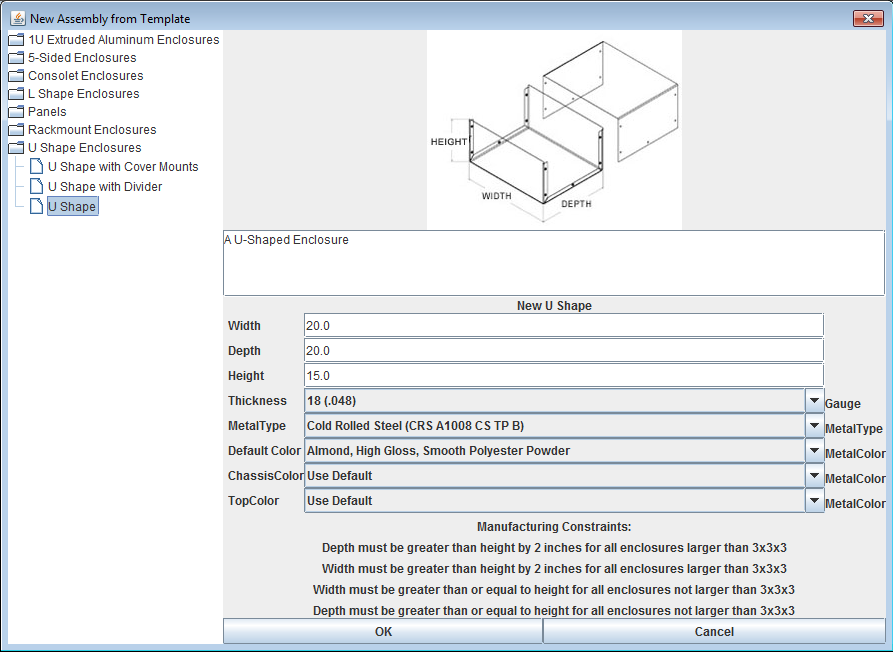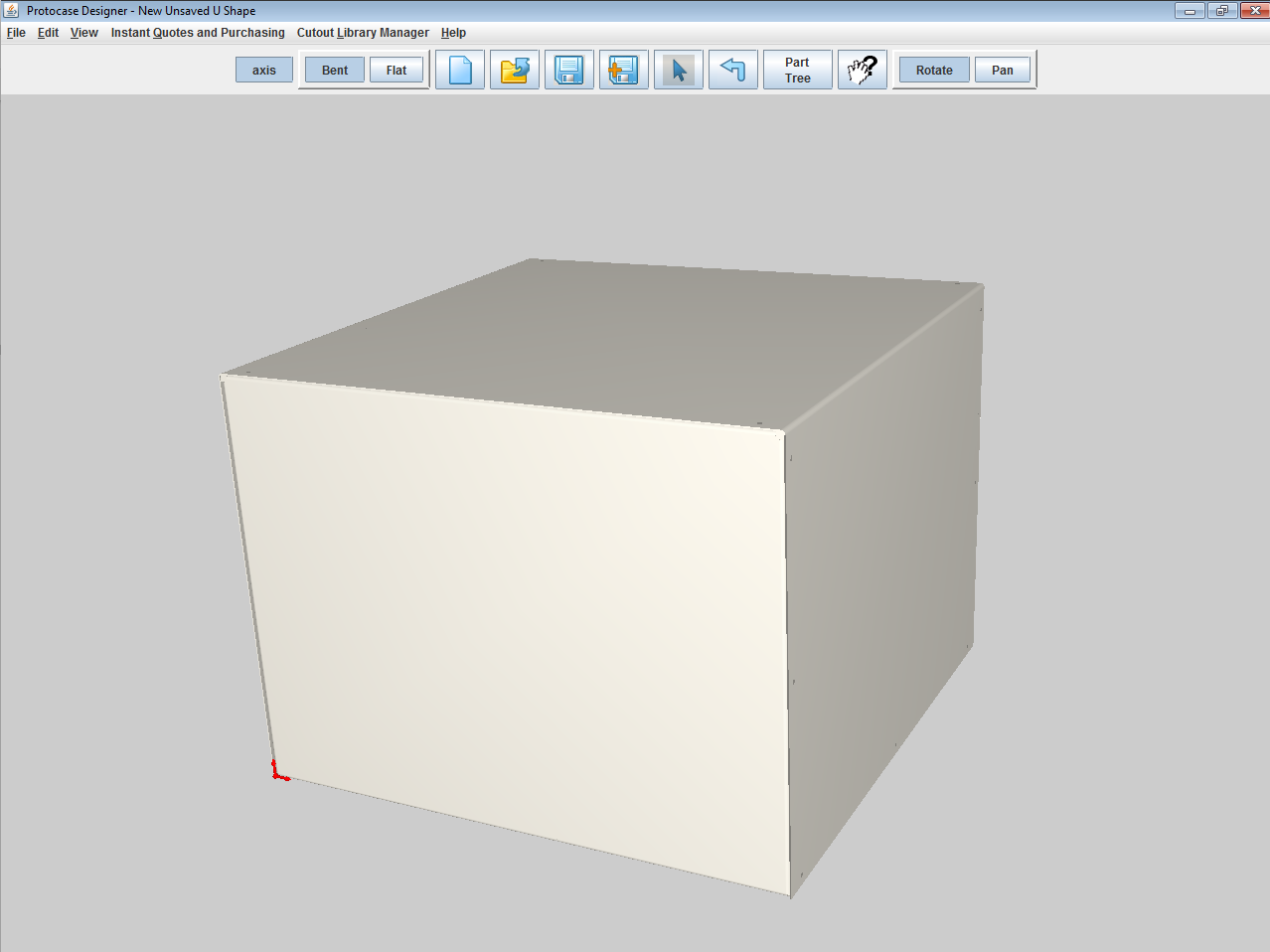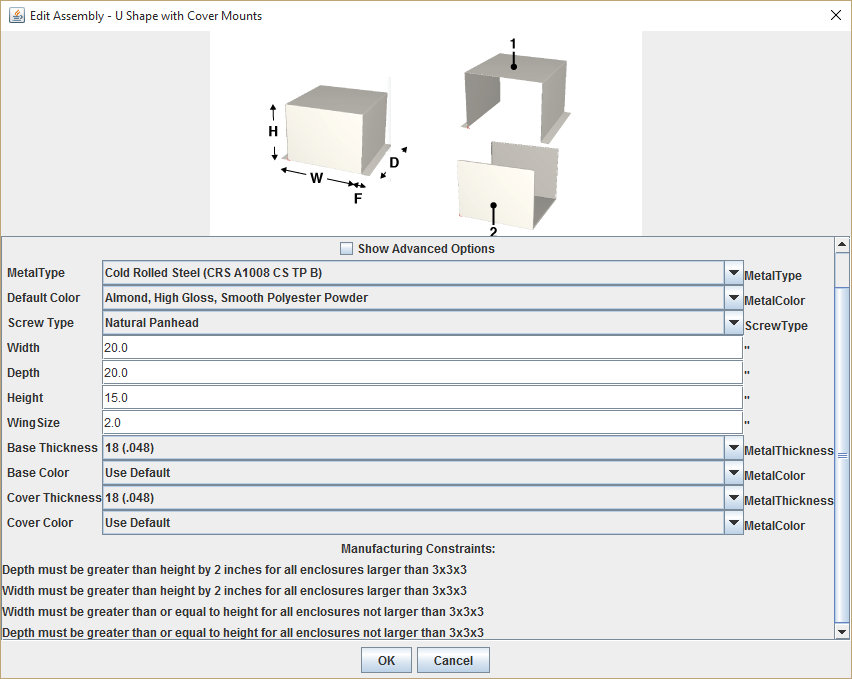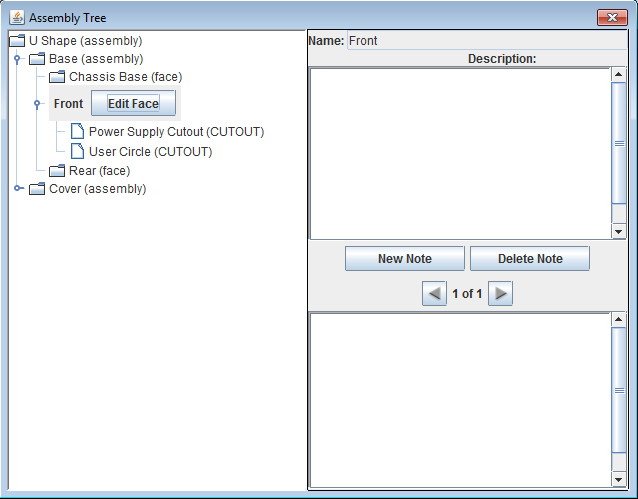Difference between revisions of "3D View Window"
m (→Reset view) |
m (→Editing a face using the Face Editor) |
||
| Line 92: | Line 92: | ||
#Rotate the model to show the face you want to edit. | #Rotate the model to show the face you want to edit. | ||
#Click the '''Edit Face''' button on the toolbar. [[File:button-editface.png|40px|bottom]]. The pointer will change to a crosshair. | #Click the '''Edit Face''' button on the toolbar. [[File:button-editface.png|40px|bottom]]. The pointer will change to a crosshair. | ||
| − | #Click a face to edit. The [[Face Editor|Face Editor window]] opens. | + | #Click a face to edit. The [[Face Editor|Face Editor window]] opens.<br><br> |
=Viewing the Part Tree= | =Viewing the Part Tree= | ||
Revision as of 14:07, 12 April 2016
Contents
3D View Window overview
The 3D View window displays a 3D model of your enclosure that you can manipulate.
A: 3D View Toolbar
B: Viewport
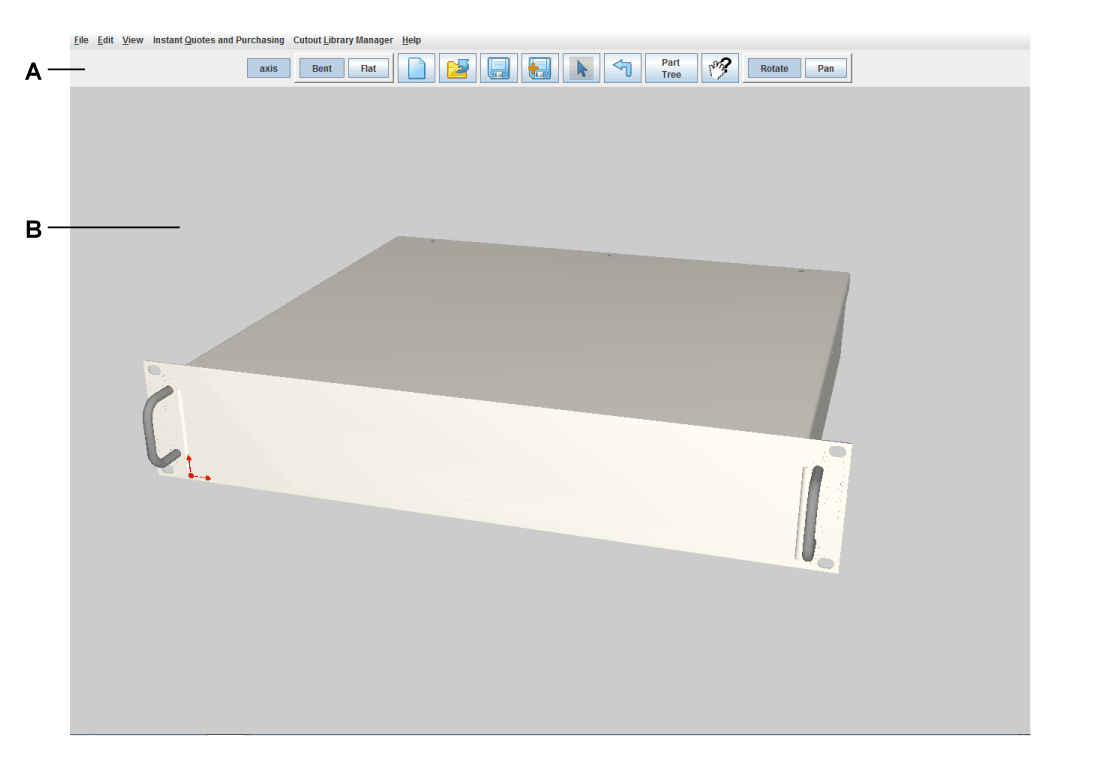
3D View Window Preferences
Note: If you like to use a different unit of measure or have other preferences when using Designer, you can set global parameters in the Preferences dialog box.
Creating, opening, and saving assembly files
Creating a new assembly
- Click the New File button in the Pick An Option To Start window, cChoose File > New, or click the Make New Enclosure From Template button
 in the 3D View toolbar. The New Assembly dialog opens.
in the 3D View toolbar. The New Assembly dialog opens.
- Select an assembly category on the left and then select an assembly.
- Modify the assembly parameters including size, thickness, material, and colour to meet your design requirements, conforming to any Manufacturing Constraints if they are listed at the bottom of the window. See Changing enclosure properties below for details.
- Note: To create a custom bracket with cutouts and other elements, you use the 3D View window to create it, then you use the Face Editor to customize it and to add it to a face. See Creating and adding brackets for step-by-step instructions.
- Click OK to view the 3D model.
Opening an existing assembly
- In the 3D View window, choose Open from the File menu, or click the Open button on the toolbar.
- Select the file you want to open.
Saving an assembly
Files are saved in .PDA (Protocase Designer) format.
- Choose File > Save or click the Save button on the toolbar.
- If this is the first time the assembly is being saved, the Save dialog box opens. Select a location and enter a name for the file, then click Save.
Saving a copy of an assembly
- Choose Save As from the File menu, or click the Save As button on the toolbar.
- In the Save dialog box that opens, select a location to save the file and enter a new name for the assembly, then click Save.
Changing assembly properties
At any point after you create a new assembly (enclosure, bracket, or panel) you can modify its properties such as size, thickness, material, colour, and screw type.
- On the Edit menu, click Edit Enclosure Properties. The Edit Assembly dialog is displayed.
- Change any of the enclosure properties, being sure to conform to any Manufacturing Constraints if they are listed at the bottom of the dialog.
- If the template includes screws, the Screw Type is displayed with a default value. (Brackets and panels do not use screws.) To change the default screw, click the Screw Type down-arrow and choose the color (Black, Natural [Zinc], or Stainless) and type (Flathead or Panhead).
- To save the modifications, click OK.
Note
- When you select a rackmount enclosure template, the parameters include the Full Height Chassis check box. Selecting this checkbox causes the screws to be countersunk, and the enclosure the same height as the front of the rackmount.
Transferring an enclosure design
- Open the design that you want to transfer.
- In the 3D View, choose File > Transfer to New Enclosure.
- In the Transfer Design to New Assembly dialog that opens, select the new enclosure and modify parameters as needed.
- Designer will transfer parameters for enclosures of the same category; for example, if you are transferring between two types of Extruded enclosures, nothing needs to be changed. However, if you are transferring from a U Shape to a Rackmount, you may need to change some parameters manually.
- Click OK.
- An untitled dialog opens, in which the face names of the original enclosure are listed on the left, and to the right of each name is a column of potential face names for the new enclosure. When the two designs use different names for a face (for example, a Rackmount has a "front panel," whereas a 1U Extruded has a "front plate," whereas a U Shape has just a "front"), select the appropriate face name for the new design. Many of these are pre-selected, but check them all and change the name or choose "Drop This Face" as necessary.
- Tip If you are unsure of a face name for an enclosure, you can check by loading the enclosure and viewing the face in the Face Editor. The face name is displayed in the Status Bar at the bottom of the Face Editor screen.
- Click OK when done (or Cancel to abandon the new enclosure template and return to your original design).
- Check each element of the new design against your original. For some transfers, the cutouts may need to be flipped or moved manually.
Viewing the model
There are several controls to allow viewing and manipulating the 3D model of your enclosure.
Rotate model
The Rotate command spins the model around its center.
- On the 3D View toolbar, click the Rotate button.
- Drag the model to rotate it to the desired orientation.
Pan model
To move the model around the plane of the viewport, do any of the following:
- Right-click the model and drag it.
- Press and hold down the <Alt> key, then click and drag the model.
- Click the Pan button on the toolbar, then click and drag the model.
Zooming
To zoom the model in or out, rotate the wheel button forward or backward.
Notes
- The model zooms in/out from the centre of the viewport, regardless of the pointer location.
- If your pointing device does not have a wheel, open the Face Editor and use the Zoom In and Zoom Out buttons on the toolbar or the Zoom commands in the View menu.
Show/Hide Parts
The Show/Hide Parts command lets you view inside the model by hiding one or more parts.
- On the View menu, click Show/Hide Parts. The Show/Hide Parts dialog box is displayed.
- Select or clear the appropriate check boxes to show or hide parts.
Toggle flat/bent view
The Toggle Flat and Bent commands displays the enclosure parts as they are laid out prior to the bending process during manufacturing. These commands are for reference only, and do not affect the manufacturing of the final enclosure. You can do either of the following:
- On the Toolbar, click the Flat button to display the model in a flat view, or click the Bent button to display the model in the default bent view.
- Choose Toggle Flat from the View menu to change between the two views.
Reset view
The Reset View command displays the model in the center of the viewport in its original orientation.
- Click the Reset View button on the toolbar, or choose Reset View from the View menu.
Editing a face using the Face Editor
The Face Editor is used to add features such as cutouts, graphics, exclusion zones, and construction lines to a face.
To open the Face Editor:
- Rotate the model to show the face you want to edit.
- Click the Edit Face button on the toolbar.
 . The pointer will change to a crosshair.
. The pointer will change to a crosshair. - Click a face to edit. The Face Editor window opens.
Viewing the Part Tree
The Part Tree shows a hierarchical list of all the faces and objects in your enclosure. You can change the name and description of objects as well as open a face in the Face Editor Window directly from the Part Tree.
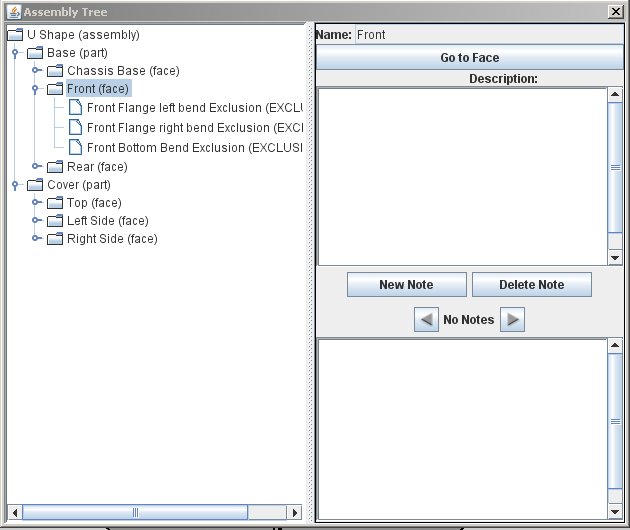
- Click the icon to the left of a face to display the objects on that face below.
- Click an object name to display description, and notes on the right of the Part Tree window.
Change object name and description
- Click an object name on the left.
- Type a new name or description on the right.
Add/Delete notes
You can add notes to parts, faces, and objects for your own reference or to provide additional information to technical support such as "Please scrub this with a scouring pad". You can also use it to place features that might not be permitted in Protocase Designer® but can be manufactured with certain restrictions. For example, you could create a circle using construction lines near the edge of a face on the exclusion zone (where you wouldn't normally be able to place a self-clinching standoff) and add a note "Add 6-32 x 3/8" standoff here".
- Click an object name on the left.
- Do one of the following:
- If there are no notes, type a note in the notes field.
- If there are existing notes, click New Note and type a note in the notes field.
- Click the arrows to view each note.
- Click Delete Note to delete the currently displayed note.
Editing a face from the Part Tree
Note: The Part Tree window can also be accessed from the Face Editor.
